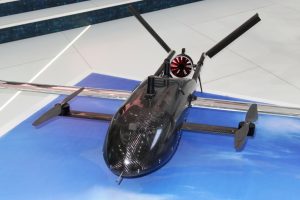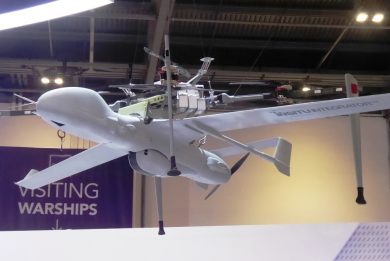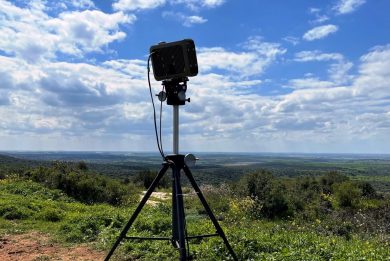
WDS 2024 – Wakeb unveils its new Khataf UAS and showcases its AI capabilities
Founded in 2017, Wakeb is a Saudi company specialised in artificial intelligence, machine learning, cognitive computing, intelligent applications, and software. It is also active in the UAS domain, and at the World Defense Show it unveiled the Khataf long range VTOL, which of course has embedded AI-based algorithms
In its booth at the Riyadh exhibition Wakeb was exhibiting most of its UAS portfolio, among which the 13 kg maximum take-off weight (MTOW) Tairat Shalwa long range reconnaissance VTOL airframe capable to carry a 5 kg payload with an endurance of 10 hours, as well as its evolution, the Tairat Shalwa 2, with a different aerodynamics and a lesser endurance, the short range Nashmiah quadcopter being also on stage.
However, the new member of the family unveiled at WDS was the Khataf long range VTOL system which features a peculiar aerodynamic architecture.

The 13 kg MTOW aircraft has an aerodynamic fuselage with two rear struts, carrying each one half the tailplane, angled to obtain a V-shape. It has a straight mid wing with a 3.3 metres span, which can be disassembled for transport. Ahead of the wing we find a canard, with a span of around 0.7 metres, which carries at each wingtip a two-blade rotor providing the VTOL capability. These being the only systems providing vertical lift thrust, it is to assume they should be located at the centre of gravity. To move forward and fly aerodynamically, the Khataf is fitted with a shrouded turbine-like 12-blade propeller moved by an electric motor and installed halfway between the two rear struts. In horizontal flight the three aerodynamic surfaces should ensure the right balance as the wing is backwards compared to the centre of gravity. No information was provided on power generation. According to data available the powerplant solution adopted on the Khataf makes it the fastest UAS within the Wakeb portfolio, as it can reach 250 km/h, compared to the 150 km/h of the aforementioned fixed wing VTOL UAS.
The new UAS can fly at a 4,000 ft altitude and has an up to 10-hour endurance, 8-9 hours being the usual endurance, flight distance being 800 km. Maximum payload is 5 kg; this can be a day night electro-optic gimbal, RGB camera and LiDAR, these probably providing sensor fused images based on deep learning, international mobile subscriber identity-catcher and E/O gimbal, or other types of payloads, the system having an open electronic architecture. Sensors are acquired from third parties, a Wakeb representative told EDR On-Line, underlining however that the software was developed by the company, a specialty of the house, both for the air vehicle control as well as for exploiting the data provided by sensors.

At the Wakeb booth it was possible to witness one of the IA-based products, the MESBAR, capable among other modes to provide automatic target recognition of land, naval and aerial targets. It can provide target distance and speed, can track multiple objects at the same time, and ensures full sensor fusion, all this also in low visibility and challenging atmospheric conditions.
According to our source, Wakeb is focusing on autonomy and is dealing with swarm capabilities, which might be added to the Khataf as well as to other company UAS.
Photos by P. Valpolini


